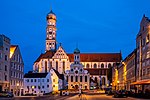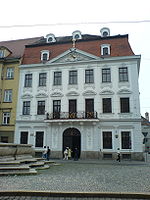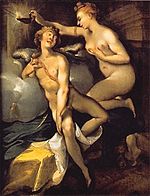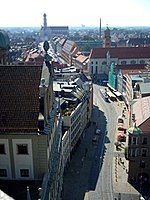St. Ulrich's and St. Afra's Abbey

St. Ulrich's and St. Afra's Abbey, Augsburg (German: Kloster Sankt Ulrich und Afra Augsburg) is a former Benedictine abbey dedicated to Saint Ulrich and Saint Afra in the south of the old city in Augsburg, Bavaria. From the late 16th century onward, the Abbey of St. Ulrich and St Afra was one of the 40-odd self-ruling imperial abbeys of the Holy Roman Empire and, as such, was a virtually independent state. The territory of that state was very fragmented: the abbey of St. Ulrich and St Afra proper enclaved within the Free Imperial City of Augsburg, and several small territories disseminated throughout the region. At the time of its dissolution in 1802, the Imperial Abbey covered 112 square kilometers and had about 5,000 subjects.
Excerpt from the Wikipedia article St. Ulrich's and St. Afra's Abbey (License: CC BY-SA 3.0, Authors, Images).St. Ulrich's and St. Afra's Abbey
Peter-Kötzer-Gasse, Augsburg Innenstadt
Geographical coordinates (GPS) Address Website Nearby Places Show on map
Geographical coordinates (GPS)
| Latitude | Longitude |
|---|---|
| N 48.3614 ° | E 10.9004 ° |
Address
St. Ulrich und Afra
Peter-Kötzer-Gasse
86150 Augsburg, Innenstadt
Bavaria, Germany
Open on Google Maps








